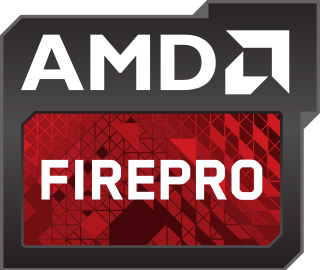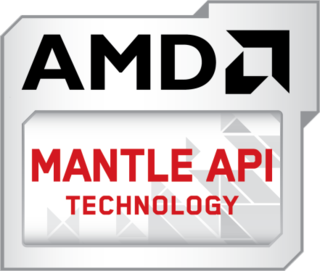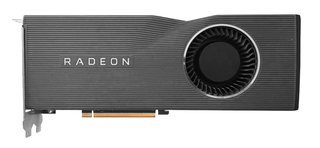
Radeon is a brand of computer products, including graphics processing units, random-access memory, RAM disk software, and solid-state drives, produced by Radeon Technologies Group, a division of AMD. The brand was launched in 2000 by ATI Technologies, which was acquired by AMD in 2006 for US$5.4 billion.

AMD CrossFire is a brand name for the multi-GPU technology by Advanced Micro Devices, originally developed by ATI Technologies. The technology allows up to four GPUs to be used in a single computer to improve graphics performance.

AMD FirePro was AMD's brand of graphics cards designed for use in workstations and servers running professional Computer-aided design (CAD), Computer-generated imagery (CGI), Digital content creation (DCC), and High-performance computing/GPGPU applications. The GPU chips on FirePro-branded graphics cards are identical to the ones used on Radeon-branded graphics cards. The end products differentiate substantially by the provided graphics device drivers and through the available professional support for the software. The product line is split into two categories: "W" workstation series focusing on workstation and primarily focusing on graphics and display, and "S" server series focused on virtualization and GPGPU/High-performance computing.
Unified Video Decoder is the name given to AMD's dedicated video decoding ASIC. There are multiple versions implementing a multitude of video codecs, such as H.264 and VC-1.
The Evergreen series is a family of GPUs developed by Advanced Micro Devices for its Radeon line under the ATI brand name. It was employed in Radeon HD 5000 graphics card series and competed directly with Nvidia's GeForce 400 series.
AMD PowerPlay is the brand name for a set of technologies for the reduction of the energy consumption implemented in several of AMD's graphics processing units and APUs supported by their proprietary graphics device driver "Catalyst". AMD PowerPlay is also implemented into ATI/AMD chipsets which integrated graphics and into AMD's Imageon handheld chipset, that was sold to Qualcomm in 2008.

The Radeon HD 7000 series, codenamed "Southern Islands", is a family of GPUs developed by AMD, and manufactured on TSMC's 28 nm process.
Graphics Core Next (GCN) is the codename for a series of microarchitectures and an instruction set architecture that were developed by AMD for its GPUs as the successor to its TeraScale microarchitecture. The first product featuring GCN was launched on January 9, 2012.

The Radeon HD 8000 series is a family of computer GPUs developed by AMD. AMD was initially rumored to release the family in the second quarter of 2013, with the cards manufactured on a 28 nm process and making use of the improved Graphics Core Next architecture. However the 8000 series turned out to be an OEM rebadge of the 7000 series.

Mantle was a low-overhead rendering API targeted at 3D video games. AMD originally developed Mantle in cooperation with DICE, starting in 2013. Mantle was designed as an alternative to Direct3D and OpenGL, primarily for use on personal computers, although Mantle supports the GPUs present in the PlayStation 4 and in the Xbox One. In 2015, Mantle's public development was suspended and in 2019 completely discontinued, as DirectX 12 and the Mantle-derived Vulkan rose in popularity.
Video Code Engine is AMD's video encoding application-specific integrated circuit implementing the video codec H.264/MPEG-4 AVC. Since 2012 it was integrated into all of their GPUs and APUs except Oland.

TrueAudio is the name given to AMD's ASIC intended to serve as dedicated co-processor for the calculations of computationally expensive advanced audio signal processing, such as convolution reverberation effects and 3D audio effects. TrueAudio is integrated into some of the AMD GPUs and APUs available since 2013.

AMD PowerTune is a series of dynamic frequency scaling technologies built into some AMD GPUs and APUs that allow the clock speed of the processor to be dynamically changed by software. This allows the processor to meet the instantaneous performance needs of the operation being performed, while minimizing power draw, heat generation and noise avoidance. AMD PowerTune aims to solve thermal design power and performance constraints.

The Radeon 300 series is a series of graphics processors developed by AMD. All of the GPUs of the series are produced in 28 nm format and use the Graphics Core Next (GCN) micro-architecture.
The Radeon 400 series is a series of graphics processors developed by AMD. These cards were the first to feature the Polaris GPUs, using the new 14 nm FinFET manufacturing process, developed by Samsung Electronics and licensed to GlobalFoundries. The Polaris family initially included two new chips in the Graphics Core Next (GCN) family. Polaris implements the 4th generation of the Graphics Core Next instruction set, and shares commonalities with the previous GCN microarchitectures.

Radeon Pro is AMD's brand of professional oriented GPUs. It replaced AMD's FirePro brand in 2016. Compared to the Radeon brand for mainstream consumer/gamer products, the Radeon Pro brand is intended for use in workstations and the running of computer-aided design (CAD), computer-generated imagery (CGI), digital content creation (DCC), high-performance computing/GPGPU applications, and the creation and running of virtual reality programs and games.

The Radeon 500 series is a series of graphics processors developed by AMD. These cards are based on the fourth iteration of the Graphics Core Next architecture, featuring GPUs based on Polaris 30, Polaris 20, Polaris 11, and Polaris 12 chips. Thus the RX 500 series uses the same microarchitecture and instruction set as its predecessor, while making use of improvements in the manufacturing process to enable higher clock rates.

The Radeon RX 5000 series is a series of graphics processors developed by AMD, based on their RDNA architecture. The series is targeting the mainstream mid to high-end segment and is the successor to the Radeon RX Vega series. The launch occurred on July 7, 2019. It is manufactured using TSMC's 7 nm FinFET semiconductor fabrication process.












